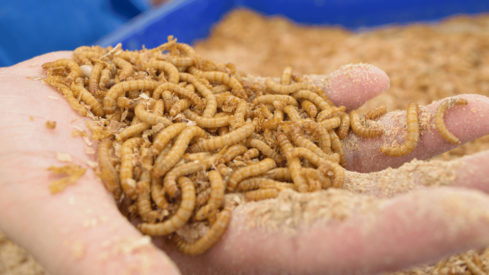Insect pet food: an update

The rapidly growing number of start-ups and technological developments are helping advance this sector.
In 2021, Future Market Insights valued the insect pet food market at $7.09 billion (€6.39B). Today, the same research firm puts this sector at $13.41 billion (€12.09B) – that’s almost double the value in 2 years. The category is expected to grow at a yearly 10% by 2033.
Expanding footprint
Among a flurry of new start-ups expanding this industry, there’s an increased focus on providing insect ingredients to pet food manufacturers.
French insect farming firm Ÿnsect has recently undergone an identity change and moved its ingredient product portfolio to be part of Sprÿng. The B2B2C focus of Sprÿng is key, with its 4 insect-derived ingredients boasting the highest level of protein on the market at 71%.
Ÿnsect recently secured $174 million (€160M) in Series D funding, and expects to close a second round of investment later in the year. The company also hopes to accelerate its international presence in markets with greater demand for premium pet food products, including the US, Mexico and Europe.
More investment
Ÿnsect is far from the only insect pet food brand receiving a capital injection. UK start-up Tuggs, which claims to be the country’s first insect-based fresh dog food producer, raised £500,000 (€560,000 / $641,000) in a pre-seed round earlier in the year.
The brand offers an experiential approach: pet parents are asked to fill in an automated questionnaire about their animals, the results of which dictate a personalized meal plan.
Tuggs worked with nutritionists to create the proprietary algorithm to work out how many calories a dog needs daily. It combines this with analyses on each dog breed in the UK, producing a metabolism and maturity score to make a tailored food plan.
The company aims to tackle pet obesity – over half of British dogs and cats are believed to be overweight – and make pet owners’ lives easier. It’s a tech-led approach that’s a marker of the sector’s direction.
Sustainability
The other aspect that insect-based food is riding its wave on, is sustainability. “We’ve found the nutritional composition of the insects that we use to be very similar to established proteins such as beef – except the black soldier fly (BSF) uses a fraction of the carbon ‘paw print’,” notes Tuggs’ founder Harry Bremner. “You’re reducing your reliance on livestock without compromising on any nutritional benefits.”
Finland will see its first circular insect protein production plant by Volare, which is expected to produce 5,000 tons of insect protein and lipids a year. The ingredient supplier prides itself on using low-value materials – insects, in this case – to make high-quality proteins and oils. And the insect residue that can’t be turned into ingredients is used in fertilizers.
French insect company Innovafeed is building a BSF larvae production facility to manufacture oil and protein in Illinois, which uses an industrial symbiosis model that could reduce the factory’s carbon footprint by 80%. BSF oil is also posed as a greener alternative to tropical oils such as coconut and palm, potentially preserving the natural habitats of orangutans and other endangered species, as well as presenting an eco- positive oil option to pet food brands.
The power of waste
Volare takes waste from the food industry and feeds it to the BSF larvae, turning them into proteins and fats in just a few weeks. BSF, which has 17 enzymes in its belly (compared to 8 for humans), is an “amazing biomaterial converter”, according to the company’s founder Tuure Parviainen.
“BSF can digest food waste and organic materials more efficiently than any other known insect species,” he explains. “Part of this is because of the symbiotic nature of the microbes in its gut. This allows the fly to increase its weight fivefold in a single day. Most amazingly, it stops eating when fully grown, which only takes 14 days.”
Since raising €1.1 million ($1.2M) in 2021, Volare has supplied its ingredients to Alvar Pet and Leo & Wolf, for dog treats and bird seed bars respectively. It is also collaborating with fish feed manufacturers, and plans to build similar facilities in the Nordics and in Central and Eastern Europe by 2030.
British supermarket Tesco plans to halve its food waste by 2025 and is exploring how insect farming could be a sustainable solution to achieve this target. Sarah Bradbury, Group Quality Director at Tesco, believes that by diverting food waste to grow insect protein, Tesco can turn surplus food into a “much more environmentally friendly commodity”.
The potential
Across the Atlantic, Canadian insect protein start-up Entosystem recently opened a new plant in Quebec. A year after securing over €41.5 million ($46M) in funding, the new factory has the largest production capacity for larvae (up to 5,000 tons annually) in North America.
Entosystem’s initial products, which are derived from BSF, are geared toward the pet food industry. The new facility has a zero-waste focus: it recycles organic matter from the local agri-food industry (otherwise destined to be discarded) and turns it into insect meal, doubling down on the sector’s sustainability credentials.
In Russia, insects could make up 5% of all protein in pet food in the next 3 to 4 years. That’s according to Denis Ter-Akopov, CEO of Moscow-based ONTO Biotechnology, which produces pet food made from zophobas (a type of beetle), mealworms, BSFs and dried crickets.
Russia is barely manufacturing any prescription pet food, and in the wake of its war with Ukraine, foreign companies have pulled out. ONTO is hoping to plug this gap with prescription and specialized pet food offerings, and is establishing a new production line to accelerate output.
Future challenges
Volare’s founder Tuure Parviainen believes the confluence of developing pet food that’s planet-friendly and tastes good is what’s driving the insect protein industry.
According to Tuggs’ founder Harry Bremner, the UK is “5 to 10 years behind the rest of Europe” when it comes to insect pet food, mainly due to the impact of Brexit. “Companies would rather invest in European farms that have access to a bigger market,” he admits.
“In Europe, there are many insect farms, but most are in early stages, so over the short term, I foresee challenges in the supply of fresh insects… This will be overcome only in time, as these farms need time to grow and continue with research and development.”
Funding and research
Funding is essential in this space: as with other alternatives and innovations, most insect-based pet food is pricier than conventional products.
Parviainen attributes this to supply and demand: “Currently, there isn’t enough supply to fill the demand.
Scaling the production is the key step. We also see our dry processing technology as key to reducing the production price and… energy use.”
Collaboration in the sector, further research and more veterinary approval are essential for the development of insect protein in pet food. “More and more vets are endorsing insect products, especially for hypoallergenic diets,” says Tuggs’ founder Harry Bremner.
The British company is also looking to commission a peer-reviewed study comparing the microbiome of dogs being fed commercial kibble, before transitioning to its insect-based food.
